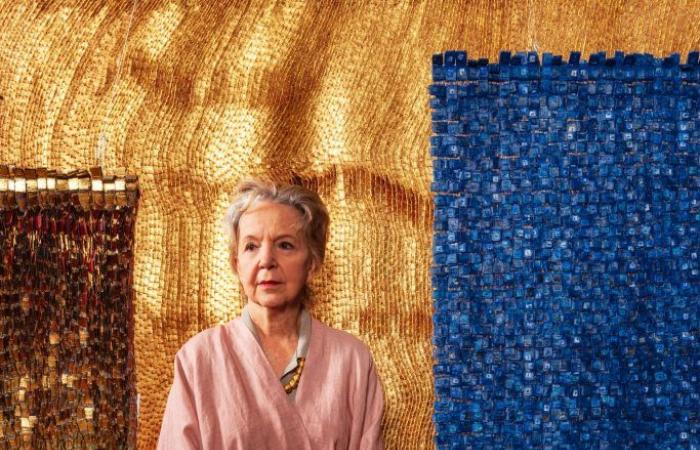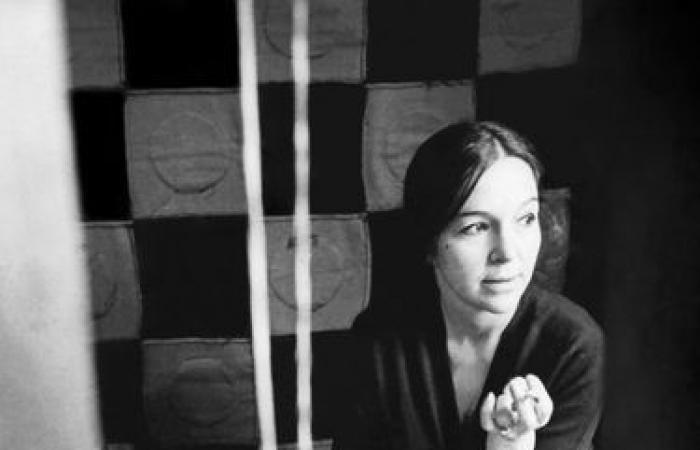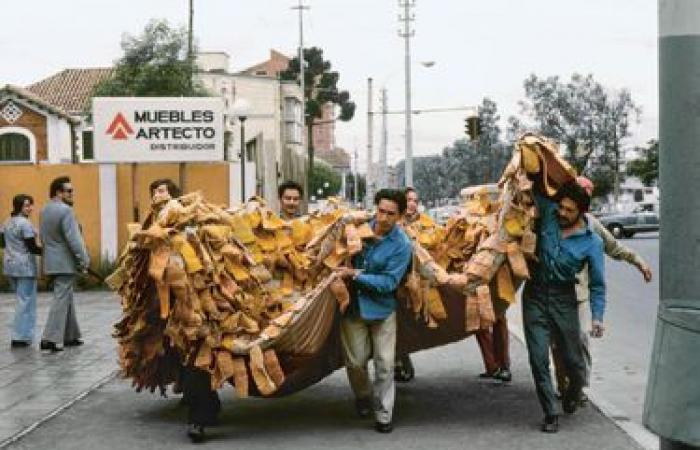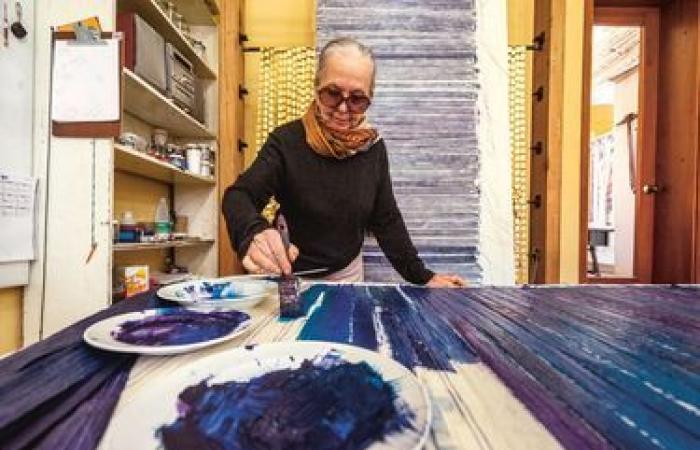Friday February 7, 2003, on Carrera 7, the chic avenue of Bogota. District of embassies and diplomatic residences. It is almost 8 p.m. when a vehicle loaded with 200 kilos of explosives defies the city’s most advanced surveillance system. In a few seconds, the prestigious twelve-story El Nogal club is nothing more than a gigantic smoking carcass.
Symbol of the “oligarchy” according to the guerrillas, the elegant building housed that evening, as usual, members of Colombian high society and the political elite. Some were celebrating at a wedding, others were sweating at squash, relaxing in the sauna or lazing in the Jacuzzi… Results of the attack attributed to the Revolutionary Armed Forces: 36 dead, 198 seriously injured. And a miracle, which the rubble has barely dusted off: the hieratic and monumental “Alquimia 85” (600 × 470 cm), a sparkling masterpiece of textile and gold by the artist Olga de Amaral.
Olga developed her artistic instinct throughout her childhood, which she spent between Medellin and the Colombian countryside, following the movements of her father, a mining engineer and entrepreneur. The imagination of the little nomad will especially remember the baroque churches and the dazzling facades of the houses of the family region of Antioquia. Architectural studies. She was so talented that she became head of the drawing department at the Colegio Mayor in Bogota in 1953, at the age of 21. Dark period.
“Alquimia 85” (600 × 470 cm), at the El Nogal club, in the Colombian capital.
© Diego Amaral
An uncontrollable territory, fragmented by impassable mountain ranges, Colombia is given over to the Violencia, this civil war of incredible brutality which will leave 300,000 dead. Unequal distribution of land, rivalries between politicians disconnected from reality, rapes, fires, pillaging, massacres… Sweet Olga flees savagery and finds refuge in the United States. She joined the Cranbrook Academy of Arts, in Michigan, where teaching was based on the modernist principles of Bauhaus, a movement which advocated the mixing of disciplines and experimentation, and according to which “there is no essential difference between ‘artist and craftsman’.
Thanks to the “art of fiber”, textiles will never again be used as tapestry
In this fertile ground for freedom, Olga learned about textile art and decided to make it her trademark. Back in Bogota, the political and social climate remains complicated. Because she knows it will be impossible to find one in Colombia, she brings her own loom from the United States. Access to fibers, the raw material for his work, is also limited. So Olga makes them herself from wool and linen, dyes them by hand with natural dyes, plays with textures and colors. She founded her small business, employing local weavers in her workshop to design works intended for interior decoration. But it was not until the 1960s that she forged her place among the fiber art artists who then established themselves internationally.
The rest after this ad
The era vibrates to the rhythm of a new wave of avant-gardes – arte povera, Fluxus, land art, conceptual art… –, determined to do battle definitively with dad’s academicism. In 1963, a small exhibition was held at the Museum of Contemporary Craft in New York which brought together five emerging artists from North America influenced by ancient Peru. Their common point, according to Paul J. Smith, then deputy director of the museum: the creation of sculptural forms from intertwined threads. Thanks to the “art of fiber”, textiles will never again be used as tapestry.
Still on the job, she puts her work back on. Here in his studio in Bogota, in 1965.
© Artist Archive
Aware of these developments, Olga draws on her modernist training in the United States and her knowledge of Latin American weaving techniques to refine her artistic language. She developed her interest in vernacular know-how. During a visit to a Quechua woman, she came away impressed by her concentration and agility and by a sort, she said, of “ancestral, highly mathematical intelligence”.
Olga experiments like a modern Penelope
Layers of fabrics that intersect, twists that contrast and wind between them, knots, twists, search for color, the rhythm of contrasts, lilac and green, scarlet red and fuchsia pink, yellow ocher and orange, use of horse hair to create increasingly rigid and imposing structures… Olga experiments like a modern Penelope. Exhibitions continued from New York to the Lausanne Biennale in 1969, where artists were allowed for the first time to show pieces at a distance from the walls, and spectators were allowed to touch the works or walk through them. the most impressive.
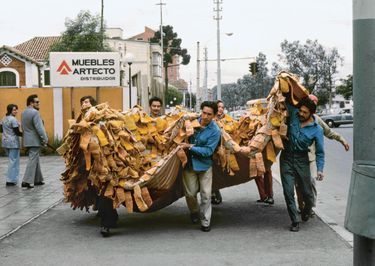
The transport of “Gran Muro” (460 × 520 cm), a work in dyed wool and horsehair, in 1976.
© Artist Archive
Olga travels. In 1970, while spending the afternoon with her friend, the ceramicist Lucie Rie, in London, her attention was drawn to a vase that had been repaired. “Lucie explained to me that she had highlighted the joint of the repair with gold, taking inspiration from the Japanese technique of kintsugi. This usage touched a mysterious place in my mind. Four years later, while living in Paris, I began using gold leaf in a small group of works. From that moment on, this material became important in my work. I started looking for ways to transform the weaving into golden, luminous surfaces. »
Entering the works of Olga de Amaral is also traveling in the cartography of territories
Marie Perennès, curator of the retrospective presented at the Fondation Cartier
At the same time tapestries, paintings, sculptures and architecture, his works seduced and orders poured in throughout the 1970s. Among the most ambitious, there was “Gran Muro” (1976), intended for the Peachtree Plaza Hotel in Atlanta: sixteen suspended panels deployed to a height of six floors. Autumn painting, yellow, orange, light brown. The colors darken at the edges of the panels to purple, pink, green and blue. Olga also stages her creations in nature, then photographs them. This is evidenced by its “Adherencia”, fluffy like a caterpillar from the Altiplano moors, clinging to a rocky slope, which merges with the environment.
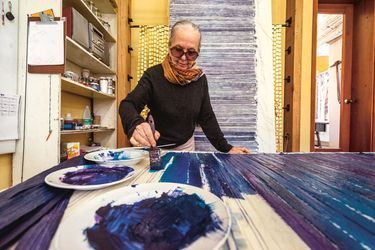
“I have always been inhabited by color and, yet, I am continually in search of its mysterious soul. » At home, in 2015.
© Diego Amaral / Artist’s archive
“Entering the works of Olga de Amaral is also traveling into the cartography of territories,” underlines Marie Perennès, curator of the retrospective presented at the Cartier Foundation. “Umbra 51” could represent the Caribbean Sea which borders northern Colombia. In “Strata 15”, it is a mountain that shines through, perhaps the iconic Sierra Nevada de Santa Marta. »
High Native American traditions mingle with the geometry of abstraction. From the 1980s, Olga found her perfect surface by weaving linen with cotton. The result, she explains, is “a clay-like fabric from which I make strips which will form the raw material. They are made up of small, perfectly proportioned, woven rectangular units. These fragments are the “words” I use to create landscapes whose surfaces and textures combine various emotions, memories, meanings and connections. » In order to cover the gaps between the fibers, Olga then brushes her weaving with gesso, a kind of coating which stiffens and gives a smoother and more regular appearance to her weaving.
This team of weavers, this place are what connects me most deeply to my country
Olga de Amaral
“I realized that gesso and stucco allowed me to add inscriptions and simple geometric shapes in bas-relief – suns, spirals, circles, squares – which enriched the meaning of the final surfaces and gave them a timeless appearance, like the glyphs and inscriptions that can be found carved into stones. To hide the dry and rough appearance that the coating gave to the units, I covered them with rice paper. This gave them a particular shine, fluid and organic, which still hinted at what was hidden underneath. To finish, I applied the gold leaf. Each of these steps leaves its mark. Weaving, joining and braiding the elements allowed me to bend, twist and drape the gold freely. But to achieve the vast imaginary landscapes I envisioned, I needed larger quantities of elements. To make them, I needed other hands, other people sharing a certain state of mind, a certain rhythm, silence, concentration and a love of manual work. »
For more than twenty-five years, she has worked with a team of weavers. “Through this collective process, each assemblage is imbued with the spirit of each of these lives and a unique patina. All these layers of work and time eventually affect the appearance of the final surface. It is difficult to explain what happens in this interval. The changes, the choices made, the pace of work, the silence or the music, the personal stories… This team of weavers, this place are what connects me most deeply to my country. »
By interweaving the horizons of her native Colombia and the ruins of a past civilization, Olga de Amaral, this star of fiber art now aged 92, continues to question us about space and time, and envelops us like a magician in a golden, aerial and iridescent world like an Inca treasure.
“Olga de Amaral”, retrospective at the Fondation Cartier, from October 12, 2024 to March 16, 2025, Fondationcartier.com.

